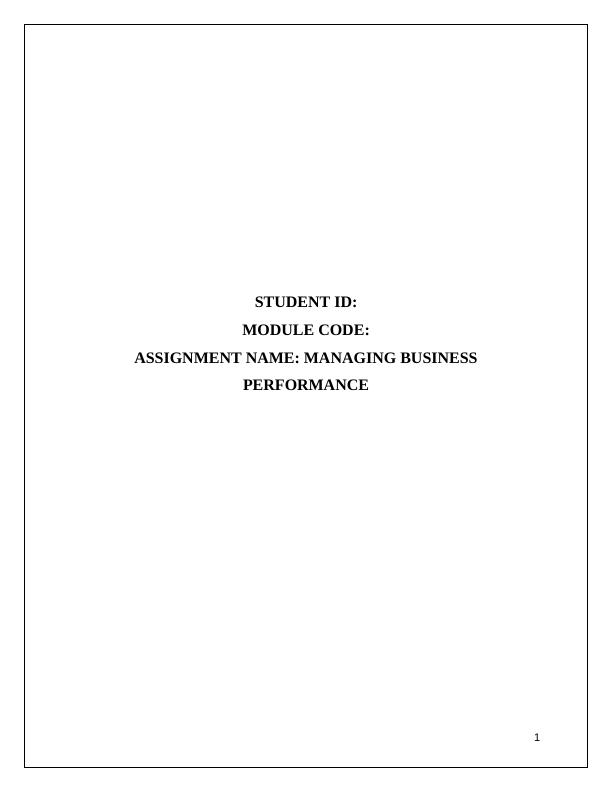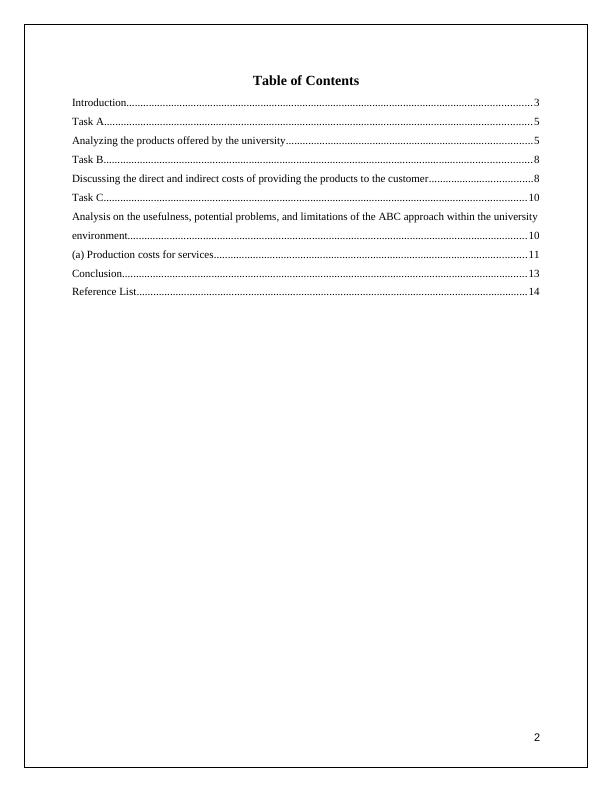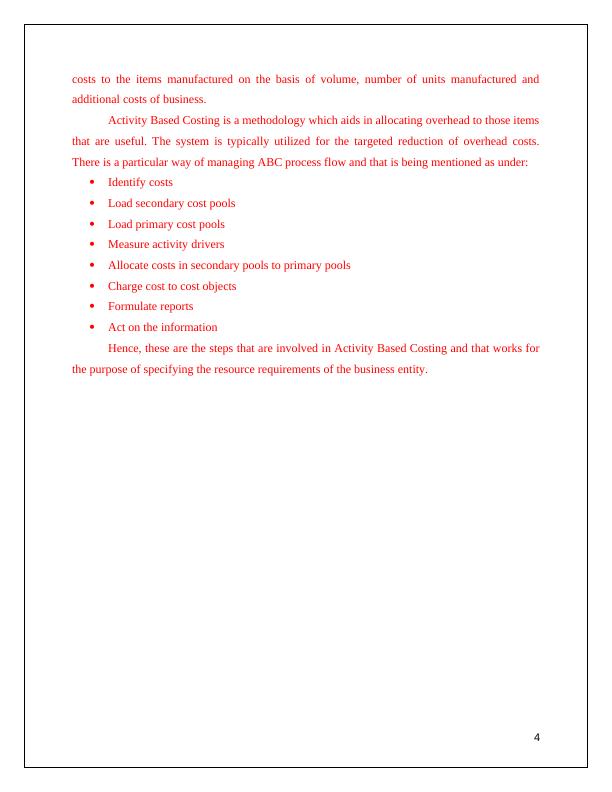11 Managing business performance
Added on 2023-04-11
15 Pages3748 Words102 Views
STUDENT ID:
MODULE CODE:
ASSIGNMENT NAME: MANAGING BUSINESS
PERFORMANCE
1
MODULE CODE:
ASSIGNMENT NAME: MANAGING BUSINESS
PERFORMANCE
1

Table of Contents
Introduction.................................................................................................................................................3
Task A.........................................................................................................................................................5
Analyzing the products offered by the university........................................................................................5
Task B.........................................................................................................................................................8
Discussing the direct and indirect costs of providing the products to the customer.....................................8
Task C.......................................................................................................................................................10
Analysis on the usefulness, potential problems, and limitations of the ABC approach within the university
environment...............................................................................................................................................10
(a) Production costs for services................................................................................................................11
Conclusion.................................................................................................................................................13
Reference List............................................................................................................................................14
2
Introduction.................................................................................................................................................3
Task A.........................................................................................................................................................5
Analyzing the products offered by the university........................................................................................5
Task B.........................................................................................................................................................8
Discussing the direct and indirect costs of providing the products to the customer.....................................8
Task C.......................................................................................................................................................10
Analysis on the usefulness, potential problems, and limitations of the ABC approach within the university
environment...............................................................................................................................................10
(a) Production costs for services................................................................................................................11
Conclusion.................................................................................................................................................13
Reference List............................................................................................................................................14
2

Introduction
Business performance refers to how the plans and approach by the business entities in the
struggle to achieve predefined business goals are applied on the market stage. Performance of the
business organization is of immense importance, which necessitates the speed of the business
approach for attaining the desired position (Hoerl and Snee, 2012, p.267). Businesses should
render performance of optimum level which requires critical monitoring and analysis. Business
performance management is a tool which encompasses the aspects of reviewing business
performance and determining better methods quick achievement of pre-requisite goals. It enables
the businesses to collect, analyze, recheck overhead business costs, resource allocation and
consumption, empirical data and make necessary recommendations. Through this, managers are
aware of the performance issues and company’s positions and thus can instantiate appropriate
decisions.
Management of business performance entails various frameworks. One of those
frameworks is Activity-Based Costing (ABC). As the name suggests, ABC is a framework which
measures the frequently adopted business, with diversity in design and use, providing insights
into what is providing value for to the customers. Activity-Based model was developed to
ascertain the overhead costs and their allocation to individual consumers and products. It
facilitates the allocation costs by organizations making adjustments to overhead costs that do not
model with the business propositions. ABC, being a strategic management tool, establishes direct
links between the performed activities and output generated (Hicks, 2012, p.257). The work flow
in ABC is a chain process, from the activities to products, services con consumers.
A costing system is typically designed for the purpose of monitoring the costs incurred by
the business entity. The system is comprised of different processes, controls and reports that are
designed to aggregate and report to management about revenues, costs and profitability. The
reports of a costing system are intended for internal use; hence it is not subjected to any
accounting framework.
The traditional method of cost accounting refers to the allocation of manufacturing
overhead costs to the manufactured products (Hopper and Major, 2007, p.84). The traditional
method is also known as the conventional method that assigns and allocated factory’s indirect
3
Business performance refers to how the plans and approach by the business entities in the
struggle to achieve predefined business goals are applied on the market stage. Performance of the
business organization is of immense importance, which necessitates the speed of the business
approach for attaining the desired position (Hoerl and Snee, 2012, p.267). Businesses should
render performance of optimum level which requires critical monitoring and analysis. Business
performance management is a tool which encompasses the aspects of reviewing business
performance and determining better methods quick achievement of pre-requisite goals. It enables
the businesses to collect, analyze, recheck overhead business costs, resource allocation and
consumption, empirical data and make necessary recommendations. Through this, managers are
aware of the performance issues and company’s positions and thus can instantiate appropriate
decisions.
Management of business performance entails various frameworks. One of those
frameworks is Activity-Based Costing (ABC). As the name suggests, ABC is a framework which
measures the frequently adopted business, with diversity in design and use, providing insights
into what is providing value for to the customers. Activity-Based model was developed to
ascertain the overhead costs and their allocation to individual consumers and products. It
facilitates the allocation costs by organizations making adjustments to overhead costs that do not
model with the business propositions. ABC, being a strategic management tool, establishes direct
links between the performed activities and output generated (Hicks, 2012, p.257). The work flow
in ABC is a chain process, from the activities to products, services con consumers.
A costing system is typically designed for the purpose of monitoring the costs incurred by
the business entity. The system is comprised of different processes, controls and reports that are
designed to aggregate and report to management about revenues, costs and profitability. The
reports of a costing system are intended for internal use; hence it is not subjected to any
accounting framework.
The traditional method of cost accounting refers to the allocation of manufacturing
overhead costs to the manufactured products (Hopper and Major, 2007, p.84). The traditional
method is also known as the conventional method that assigns and allocated factory’s indirect
3

costs to the items manufactured on the basis of volume, number of units manufactured and
additional costs of business.
Activity Based Costing is a methodology which aids in allocating overhead to those items
that are useful. The system is typically utilized for the targeted reduction of overhead costs.
There is a particular way of managing ABC process flow and that is being mentioned as under:
Identify costs
Load secondary cost pools
Load primary cost pools
Measure activity drivers
Allocate costs in secondary pools to primary pools
Charge cost to cost objects
Formulate reports
Act on the information
Hence, these are the steps that are involved in Activity Based Costing and that works for
the purpose of specifying the resource requirements of the business entity.
4
additional costs of business.
Activity Based Costing is a methodology which aids in allocating overhead to those items
that are useful. The system is typically utilized for the targeted reduction of overhead costs.
There is a particular way of managing ABC process flow and that is being mentioned as under:
Identify costs
Load secondary cost pools
Load primary cost pools
Measure activity drivers
Allocate costs in secondary pools to primary pools
Charge cost to cost objects
Formulate reports
Act on the information
Hence, these are the steps that are involved in Activity Based Costing and that works for
the purpose of specifying the resource requirements of the business entity.
4

End of preview
Want to access all the pages? Upload your documents or become a member.
Related Documents
Activity Based Costing in Financial Management & Decision Makinglg...
|8
|665
|378
Comparison of Methods of Costinglg...
|4
|787
|126
Activity Based Costing vs Traditional Costing Systemlg...
|5
|700
|202
Activity Based Costing Of Rock Widget Organisationlg...
|19
|2699
|317
Activity Based Costing: Definition, Advantages, and Implementationlg...
|4
|1259
|167
Business Accounting Assignment : Sewing Easy Ltdlg...
|15
|3157
|29